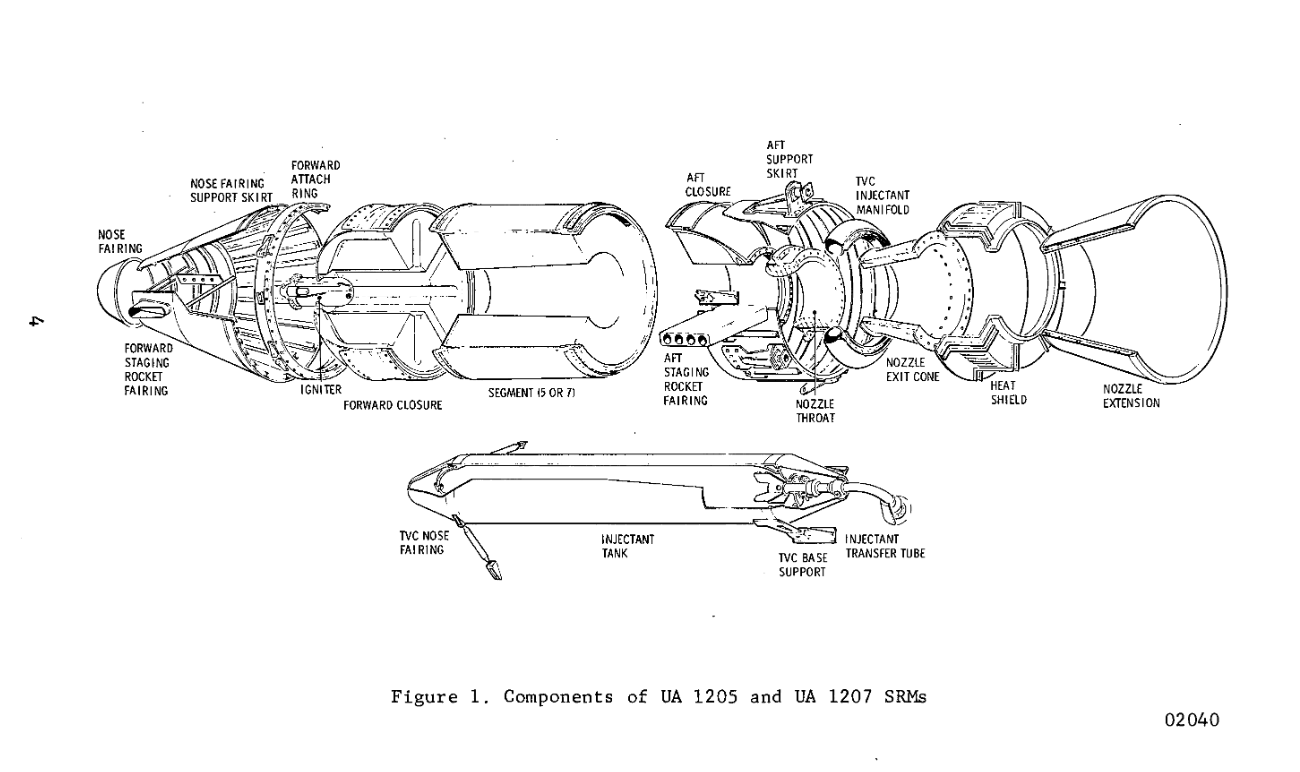UA120 on:
[Wikipedia]
[Google]
[Amazon]
 UA120 was a family of American
UA120 was a family of American
 All versions of UA120 shared a common design, with the only significant differentiating factor being the length of the motor. It was a segmented design, with between five and seven motor segments possible. A solid propellant,
All versions of UA120 shared a common design, with the only significant differentiating factor being the length of the motor. It was a segmented design, with between five and seven motor segments possible. A solid propellant,
 UA120 was a family of American
UA120 was a family of American solid rocket booster
A solid rocket booster (SRB) is a large solid propellant motor used to provide thrust in spacecraft launches from initial launch through the first ascent. Many launch vehicles, including the Atlas V, SLS and space shuttle, have used SRBs to giv ...
s, manufactured by the Chemical Systems Division of United Aircraft
The United Aircraft Corporation was an American aircraft manufacturer formed by the break-up of United Aircraft and Transport Corporation in 1934. In 1975, the company became United Technologies.
History
Pre-1930s
1930s
The Air Mail scandal ...
(later United Technologies Corporation
United Technologies Corporation (UTC) was an American multinational conglomerate headquartered in Farmington, Connecticut. It researched, developed, and manufactured products in numerous areas, including aircraft engines, aerospace system ...
). Several variants existed, with a varying number of segments.
Design
 All versions of UA120 shared a common design, with the only significant differentiating factor being the length of the motor. It was a segmented design, with between five and seven motor segments possible. A solid propellant,
All versions of UA120 shared a common design, with the only significant differentiating factor being the length of the motor. It was a segmented design, with between five and seven motor segments possible. A solid propellant, polybutadiene acrylonitrile
Polybutadiene acrylonitrile (PBAN) copolymer, also noted as polybutadiene—acrylic acid—acrylonitrile terpolymer is a copolymer compound used most frequently as a rocket propellant fuel mixed with ammonium perchlorate oxidizer. It was ...
(PBAN), was used as fuel. The stage had an external diameter of 120 inches. Attitude control in flight was provided by means of a liquid injection thrust vector control
Thrust vectoring, also known as thrust vector control (TVC), is the ability of an aircraft, rocket, or other vehicle to manipulate the direction of the thrust from its engine(s) or motor(s) to control the attitude or angular velocity of the v ...
(LITVC) system, with an external nacelle containing nitrogen tetroxide attached to the side of each booster. Solid fueled separation rockets, used to jettison the spent boosters, were affixed at the top and bottom of the stage. Thrust-termination capability, necessary for manned rockets such as the Space Shuttle
The Space Shuttle is a retired, partially reusable low Earth orbital spacecraft system operated from 1981 to 2011 by the U.S. National Aeronautics and Space Administration (NASA) as part of the Space Shuttle program. Its official program na ...
or Manned Orbiting Laboratory
The Manned Orbiting Laboratory (MOL) was part of the United States Air Force (USAF) human spaceflight program in the 1960s. The project was developed from early USAF concepts of crewed space stations as reconnaissance satellites, and was a suc ...
, was to be provided by two pyrotechnically triggered ports on the forward closure, which when opened would allow for the non-propulsive venting of exhaust gasses. The forward end of the stage contained an aerodynamic nose cone
A nose cone is the conically shaped forwardmost section of a rocket, guided missile or aircraft, designed to modulate oncoming airflow behaviors and minimize aerodynamic drag. Nose cones are also designed for submerged watercraft such a ...
, an ignitor, separation rockets, and the forward attachment ring. The aft end contained additional separation rockets, the nozzle, and a heat shield.
Variants
The overall design of each variant was very similar, the main difference being the number of segments used. This is indicated by the number at the end of each designation.UA1205
UA1205 was used as a strap-on booster on theTitan IIIC
The Titan IIIC was an expendable launch system used by the United States Air Force from 1965 until 1982. It was the first Titan booster to feature large solid rocket motors and was planned to be used as a launcher for the Dyna-Soar, though the s ...
, Titan IIID, and Titan IIIE
The Titan IIIE or Titan 3E, also known as the Titan III-Centaur, was an American expendable launch system. Launched seven times between 1974 and 1977, it enabled several high-profile NASA missions, including the Voyager and Viking planetary pro ...
rockets, and was proposed for use on several derivatives of the Saturn
Saturn is the sixth planet from the Sun and the second-largest in the Solar System, after Jupiter. It is a gas giant with an average radius of about nine and a half times that of Earth. It has only one-eighth the average density of Earth; ...
rocket family.
UA1206
The UA1206 was used as a strap-on booster on Titan 34D and Commercial Titan III.UA1207
UA1207 was used on Titan IV-A. It was proposed for several other variants of Titan III and IV, as well as derivatives of the Saturn rocket family and theSpace Shuttle
The Space Shuttle is a retired, partially reusable low Earth orbital spacecraft system operated from 1981 to 2011 by the U.S. National Aeronautics and Space Administration (NASA) as part of the Space Shuttle program. Its official program na ...
.
References
{{Titan rockets Solid-fuel rockets